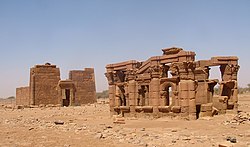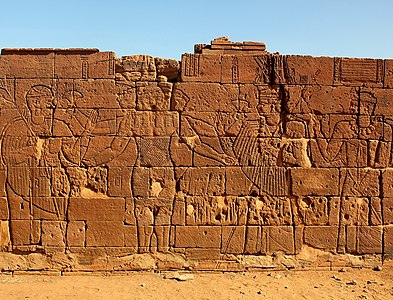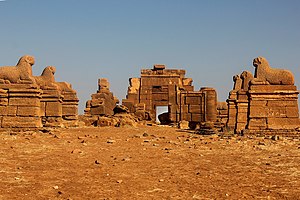Naqa
| Archaeological sites of Meroe Island | |
|---|---|
|
UNESCO world heritage |
|

|
|
| Roman kiosk with lion temple |
|
| National territory: |
|
| Type: | Culture |
| Criteria : | ii, iii, iv, v |
| Reference No .: | 1336 |
| UNESCO region : | Arabic states |
| History of enrollment | |
| Enrollment: | 2011 (session 35) |
Naqa (also Naga ; ancient Egyptian twjlkt ; Meroitic Tolkte ; Arabic النقعة an-Naqʿa , Sudanese-Arabic : in-Nagʿa ) is the name of a ruin site in today's Sudan . It is one of the largest in the country and suggests an important ancient city at this point. At the same time as the Ptolemaic Empire and the Roman emperors , it was one of the centers of the kingdom of Meroe for around half a millennium, which, as Egypt's southern neighbor, playeda bridging role between the Mediterranean and Africa. Together with Meroe and Musawwarat es Sufra , Naqa was addedto the list of UNESCO World Heritage Sites as Archaeological Sites on Meroe Island in 2011.
Geographical location
Location of Naqa in Sudan |
The place is about 170 kilometers north-north-east of Khartoum and about 35 kilometers south-south-east of the Nile . Here smaller wadis meet the Wadi Awateib, which comes from the center of the Butana region and ends further north at Wad ban Naqa on the Nile. Naqa was only a camel or donkey journey from the Nile and could have been of strategic importance as a trading post on the way east.
exploration
The first European travelers reached Naqa from 1822, including Hermann von Pückler-Muskau in 1837 . In 1843 it was visited by Richard Lepsius and his Prussian Egypt-Sudan expedition , who copied some inscriptions and depictions of the temples standing here. In 1958 a team from the Humboldt University in Berlin was on site to build the Tempel 500 z. T. documented. From 1995 a German team from the Egyptian Museum of the State Museums in Berlin was digging in Naqa . The sponsorship of the research and excavation project was transferred to the State Museum of Egyptian Art in Munich in 2013 .
buildings
The remains of various temples can be found in Naqa. King Natakamani founded the Amun and the Apedemak lion temples, both of which are still relatively well preserved.
Roman kiosk
The so-called Roman kiosk is a small temple that has strong Hellenistic elements. Recent excavations on the building have shown that it was probably a Hathor chapel.
Lion temple
The lion or Apedemak temple is dedicated to the Nubian god of war Apedemak and is considered a classic example of Cushitic architecture. The massive front pylon of the temple shows King Natakamani and the Kandake Amanitore (around 50 AD), who are subjugating their enemies, each with a lion at their feet. On the two side walls there are very well-preserved reliefs of Horus , Amun and Apedemak on the one hand and Isis , Mut , Hathor , Amesemi and Satet on the other.
Front pylon of the Lion Temple with King Natakamani and Kandake Amanitore submitting their enemies. The queen holds a sword, the king an ax
Amun temple
The 100 m long Amun Temple was founded by King Natakamani. The temple is built in the Egyptian style. Similar to the Amun temples of Jebel Barkal and Karnak , it is reached via an all of rams. The path leads to a large courtyard, which is followed by the column hall ( hypostyle ). Continuing the axis one comes to the naos .
In the temple was a stele of Queen Amanishakheto , who was previously believed to rule before Natakamani. However, the discovery of the stele in this temple built by King Natakamani makes this dating uncertain, as Queen Amanishakheto may have donated the stele to the temple during her own reign. It is possible, however, that an older monument that previously stood elsewhere was placed in the temple. Here a painted “ altar ” was found undamaged , which is considered unique in Sudan and probably also in Egypt. After excavation, reconstruction and measurement, the Temple of Amun was handed over to the Sudanese cultural authorities on December 1, 2006.
Temple 200
Another Amun temple ( Temple 200 ) has been excavated since 2004. The builder is Amanichareqerem . Numerous first-class reliefs were found here. The decoration is very similar to the lion temples of Natakamani, so that this ruler Amanichareqerem, who was previously dated to the 2nd or 3rd century AD, probably ruled very close to Natakamani. Here, too, shows how new findings can change the shaky Nubian chronology . Three reconstructed wall relief elements from Temple 200 are on permanent loan since the new opening in the Neues Museum .
Temple 500
The temple 500 stands at the foot of the sandstone mountains of Jebel Naqa (Arabic for Mount Naqa ). He was from the Kandake Shanakdakheto around 135 BC. It is the oldest building on the site. The texts on the temple walls that they name are the oldest known writings in Meroitic hieroglyphics . Judging by the reliefs, the temple was dedicated to the Theban triad Amun, Mut , and Chons and Apedemak. In 1834 Giuseppe Ferlini's temple was severely damaged while searching for treasures. An excavation and restoration is still pending.
exhibition
- 2011: Royal City of Naga - excavations in the desert of Sudan , State Museum of Egyptian Art , Munich and art forum of the Berliner Volksbank .
literature
- Inge Hofmann: The Meroitic Religion. State cult and popular piety. In: Wolfgang Haase (Hrsg.): Rise and decline of the Roman world. Part 2: Principate. Volume 18: Religion. Volume 5: Paganism. The religious conditions in the provinces (cont.) De Gruyter, Berlin 1995, ISBN 3-11-014238-4 , pp. 2801–2868.
- Dietrich Wildung , Karla Kroeper: Naga - Royal City of Ancient Sudan . State Museums in Berlin - Prussian Cultural Heritage Foundation, Berlin 2006, ISBN 3-88609-558-4 .
- Dietrich Wildung (2018): Naga. Sculpture. Ugarit publishing house. ISBN 978-3-86835-305-1
- Karla Kröper, Sylvia Schoske , Dietrich Wildung (eds.): Royal city of Naga. Digging in the desert of Sudan . Berlin, Munich 2011, ISBN 978-3-9814386-0-4 .
- P. Lenoble; 1994; A Brief Guide to Naqa, Musawwarat-Es-Sofra, Meroe.
- Alexandra Riedel, Jan Hamann: From the Quarry to the Finished Building. The Ancient Meroitic Stone Masonry at the Site of Naga / Sudan (PDF). In: Karl-Eugen Kurrer , Werner Lorenz , Volker Wetzk (eds.): Proceedings of the Third International Congress on Construction History . Neunplus, Berlin 2009, ISBN 978-3-936033-31-1 , pp. 1227-1234
Web links
- Website of the Naga project
- Association for the Promotion of the Egyptian Museum: Naga - Excavation Project
- Restoration at Oberbaum GmbH: Archaeological Park, Naga, Sudan
- University and State Library of Saxony-Anhalt: Lepsius project, temple decorations by Naga (pp. 57–68, 71)
- The Oriental Institute of the University of Chicago: Naga (photos of the Breasted Expedition 1905–1907)
- Image and film material from the excavations in Naga on Bayerischer Rundfunk
Individual evidence
- ↑ a b Inge Hofmann: The Meroitic religion: state cult and popular piety. Berlin 1995, p. 2819.
- ↑ Naqa, a ruined ancient city of the Kushitic Kingdom of Meroë. UNESCO
- ^ Project Naga. (PDF) State Museum of Egyptian Art, accessed December 7, 2014 .
- ^ State Museum of Egyptian Art: Royal City of Naga .
- ^ Stiftung Kunstforum der Berliner Volksbank: Königsstadt Naga ( Memento from February 20, 2014 in the Internet Archive )
- ↑ Ulf von Rauchhaupt : Africa's gateway to the ancient world. In: Frankfurter Allgemeine Sonntagszeitung , June 5, 2011, p. 66.
Coordinates: 16 ° 16 ' N , 33 ° 17' E






